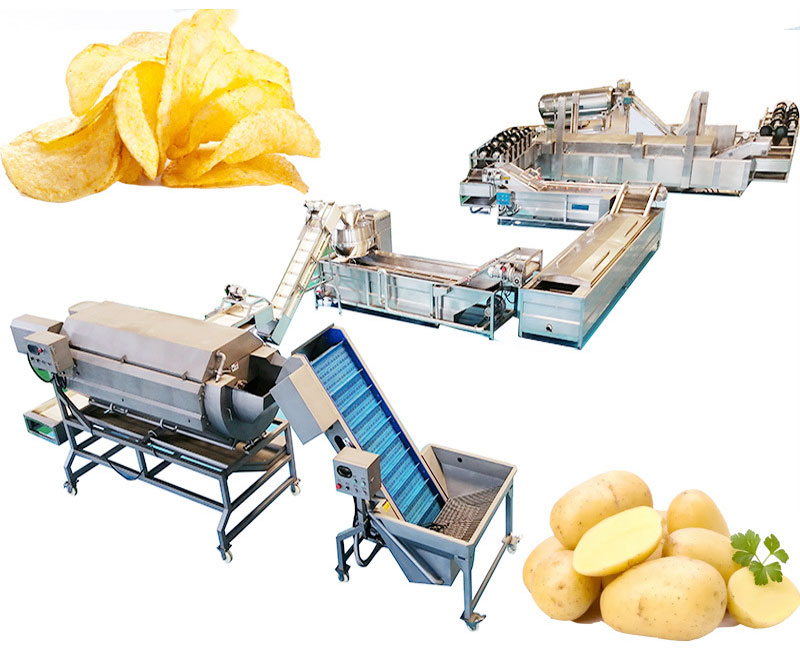The Fully Automatic Potato Chips Making Machine Price typically ranges from tens of thousands to over hundreds of thousands, depending on production capacity and configuration. This wide variance stems from potatoes’ unique properties—high starch content, irregular shapes, and susceptibility to enzymatic browning—which demand specialized engineering at every processing stage. Let’s dissect the cost drivers and how potato-specific requirements shape the machinery’s design and pricing.

Core Factors Influencing Fully Automatic Potato Chips Making Machine Price
Production Capacity & Scalability
Potato processing efficiency hinges on throughput alignment with raw material volume. Smaller lines (100–300 kg/hr) suit startups and cost tens of thousands usd, while industrial systems (500–2,000 kg/hr) reach hundreds of thousands usd. High-volume lines need reinforced components to handle continuous potato flow, increasing costs by 40–60% compared to mid-range units.
Automation Level
Potatoes’ rapid oxidation post-slicing necessitates integrated automation. Basic semi-automatic systems (e.g., standalone slicers: $1,500–$4,500) require manual transfers between stages, risking quality loss. In contrast, fully automated lines synchronize washing, slicing, frying, and packaging—reducing human touchpoints and browning risk. This adds $20,000–$50,000 to the base price but boosts yield by 15–30%.
Material & Durability
Food-grade 304 stainless steel is non-negotiable for potato acidity and abrasion resistance. While it elevates costs by 20–30% versus carbon steel, it prevents corrosion and contamination. Machines like de-oilers ($3,000–$8,000) and seasoning drums ($2,000–$7,000) use stainless contact surfaces for compliance and longevity.
Energy Efficiency
Frying constitutes 40–50% of a line’s energy use. Options include:
Electric fryers: Lower upfront cost ($15,000–$25,000) but higher operating expenses.
Gas/Diesel fryers: Priced at $30,000–$60,000, they reduce long-term costs for large-scale runs.
Potato moisture variability (75–85%) also demands precision oil-temperature control to avoid under/overcooking—adding $5,000–$10,000 for advanced thermostats.
Potato-Specific Components & Cost Impact
Cleaning/Peeling Systems:
Rotary brush peelers ($2,000–$6,000) remove dirt and skins without damaging tubers’ uneven surfaces.
Precision Slicers:
Adjustable blades (1–3 mm thickness) ensure uniform slices for even frying—critical for starch consistency. Cost: $1,500–$4,500.
Blanching & Dewatering:
Removes surface starch to prevent clumping; adds $3,000–$8,000.
Frying & Oil Recovery:
Continuous fryers with oil filtration ($15,000–$60,000) maintain crispness while reusing oil—cutting waste by 20%.
Packaging with Nitrogen Flushing:
Preserves potato chips’ freshness; systems start at $10,000.
Table: Cost Breakdown by Potato-Centric Component
Component Function Price Range Potato Property Addressed
Starch Management: Slicing thickness impacts oil absorption; adjustable blades optimize crispness.
Browning Control: Integrated lines minimize slicing-to-frying delays, preserving color.
Oil Penetration: De-oilers (centrifugal/vibratory: $3,000–$8,000) reduce excess oil in porous tissues post-frying.
Final Insights
Investing in a fully automatic potato chips line requires balancing potato-driven engineering with throughput needs. While entry systems start near tens of thousands usd, premium configurations exceed hundreds of thousands usd —justified by higher yield, lower waste, and compliance with food safety standards.
Call to Action: Maximize your potato chip venture’s ROI! Share this analysis on LinkedIn or Twitter to spark industry dialogue. Have questions about optimizing machinery for potato properties? Comment below—we’ll provide personalized insights!
Optimize your potato processing today—leveraging biology for profitability.
 Henan huafood
Henan huafood
